Organizational Behavior Theories and Concepts
VerifiedAdded on 2020/01/21
|9
|2301
|75
AI Summary
This assignment delves into the core theories and concepts of organizational behavior. Students will analyze various motivational frameworks, examine the impact of organizational culture on employee behavior, and explore different leadership styles. The assignment requires critical thinking, application of theoretical knowledge, and a clear understanding of how these concepts shape workplace dynamics.
Contribute Materials
Your contribution can guide someone’s learning journey. Share your
documents today.
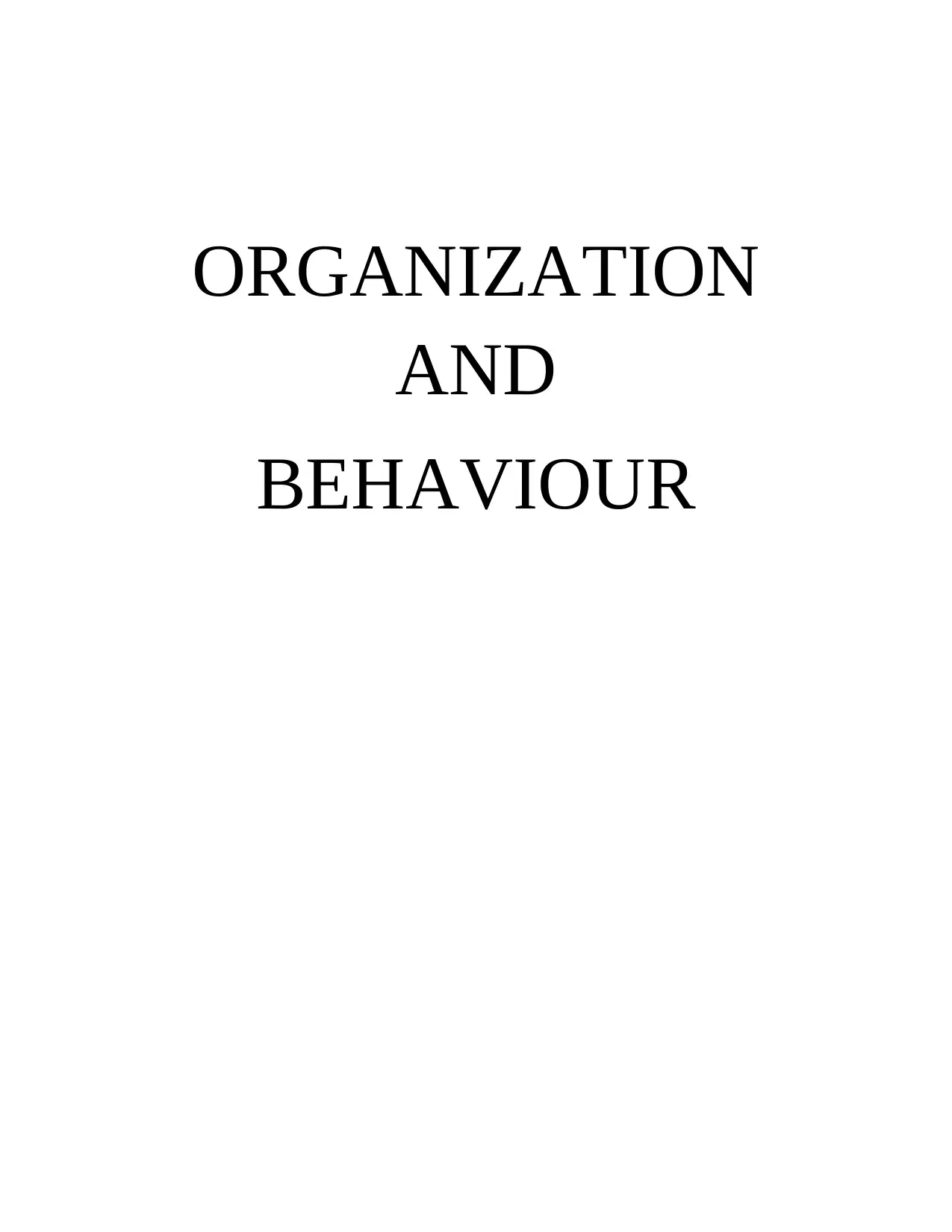
ORGANIZATION
AND
BEHAVIOUR
AND
BEHAVIOUR
Secure Best Marks with AI Grader
Need help grading? Try our AI Grader for instant feedback on your assignments.
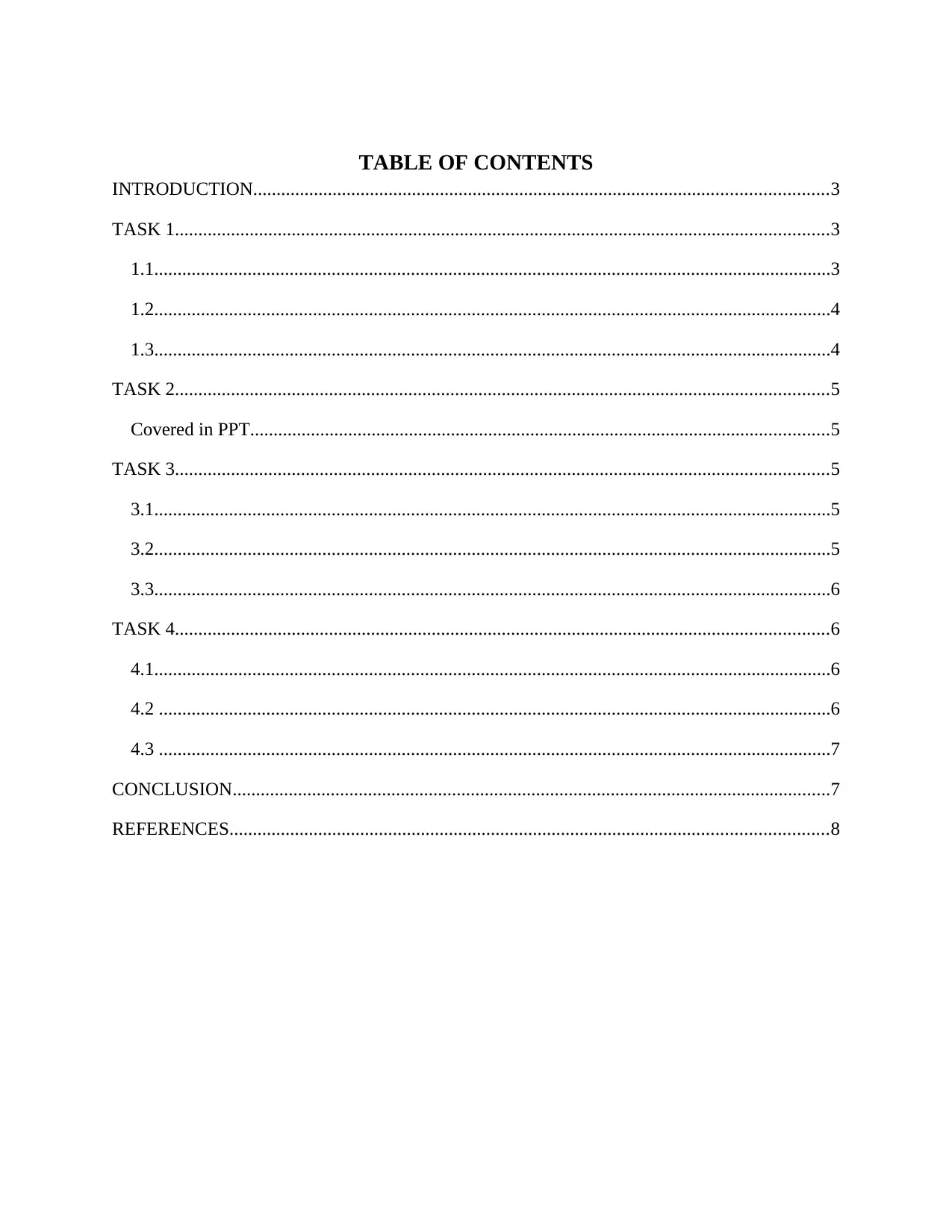
TABLE OF CONTENTS
INTRODUCTION...........................................................................................................................3
TASK 1............................................................................................................................................3
1.1.................................................................................................................................................3
1.2.................................................................................................................................................4
1.3.................................................................................................................................................4
TASK 2............................................................................................................................................5
Covered in PPT............................................................................................................................5
TASK 3............................................................................................................................................5
3.1.................................................................................................................................................5
3.2.................................................................................................................................................5
3.3.................................................................................................................................................6
TASK 4............................................................................................................................................6
4.1.................................................................................................................................................6
4.2 ................................................................................................................................................6
4.3 ................................................................................................................................................7
CONCLUSION................................................................................................................................7
REFERENCES................................................................................................................................8
INTRODUCTION...........................................................................................................................3
TASK 1............................................................................................................................................3
1.1.................................................................................................................................................3
1.2.................................................................................................................................................4
1.3.................................................................................................................................................4
TASK 2............................................................................................................................................5
Covered in PPT............................................................................................................................5
TASK 3............................................................................................................................................5
3.1.................................................................................................................................................5
3.2.................................................................................................................................................5
3.3.................................................................................................................................................6
TASK 4............................................................................................................................................6
4.1.................................................................................................................................................6
4.2 ................................................................................................................................................6
4.3 ................................................................................................................................................7
CONCLUSION................................................................................................................................7
REFERENCES................................................................................................................................8
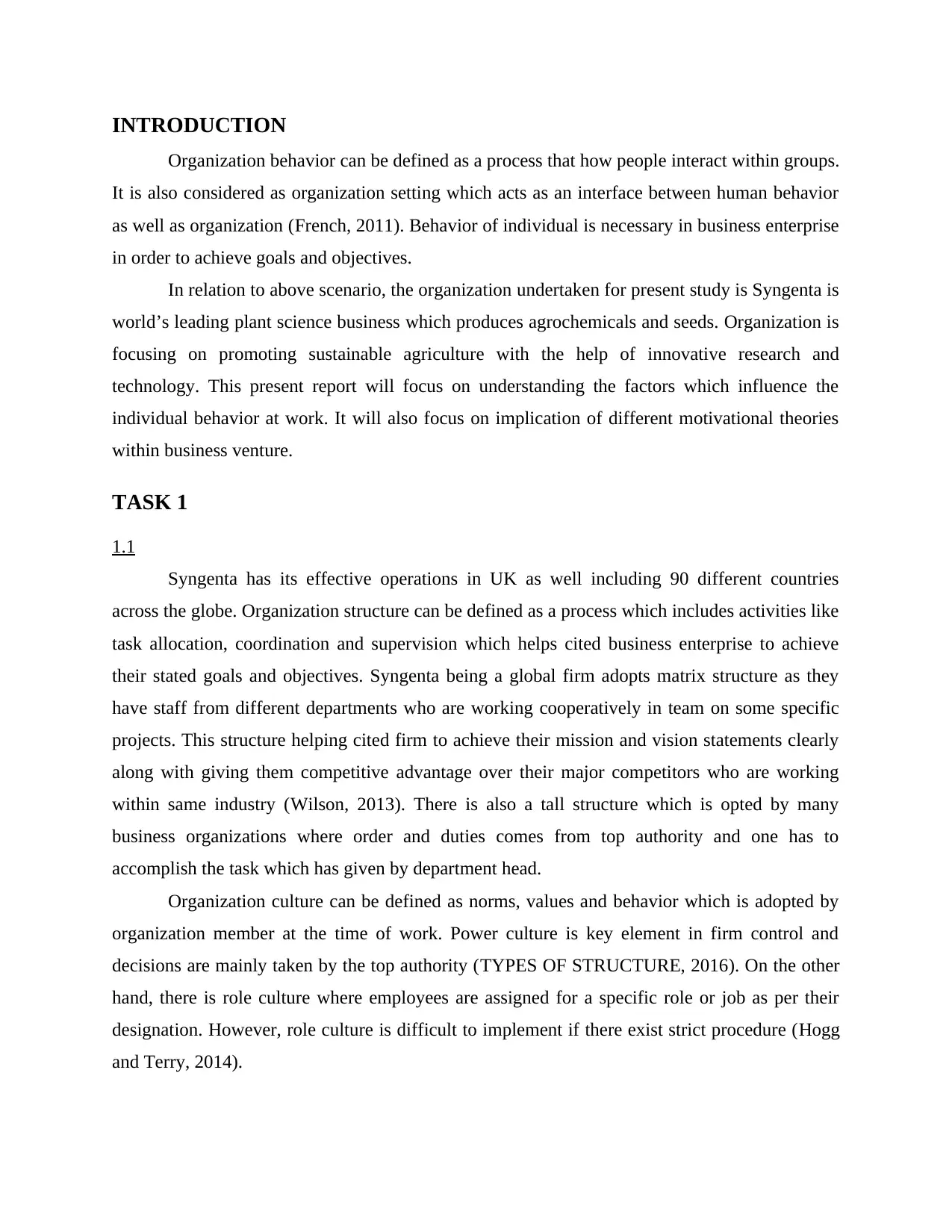
INTRODUCTION
Organization behavior can be defined as a process that how people interact within groups.
It is also considered as organization setting which acts as an interface between human behavior
as well as organization (French, 2011). Behavior of individual is necessary in business enterprise
in order to achieve goals and objectives.
In relation to above scenario, the organization undertaken for present study is Syngenta is
world’s leading plant science business which produces agrochemicals and seeds. Organization is
focusing on promoting sustainable agriculture with the help of innovative research and
technology. This present report will focus on understanding the factors which influence the
individual behavior at work. It will also focus on implication of different motivational theories
within business venture.
TASK 1
1.1
Syngenta has its effective operations in UK as well including 90 different countries
across the globe. Organization structure can be defined as a process which includes activities like
task allocation, coordination and supervision which helps cited business enterprise to achieve
their stated goals and objectives. Syngenta being a global firm adopts matrix structure as they
have staff from different departments who are working cooperatively in team on some specific
projects. This structure helping cited firm to achieve their mission and vision statements clearly
along with giving them competitive advantage over their major competitors who are working
within same industry (Wilson, 2013). There is also a tall structure which is opted by many
business organizations where order and duties comes from top authority and one has to
accomplish the task which has given by department head.
Organization culture can be defined as norms, values and behavior which is adopted by
organization member at the time of work. Power culture is key element in firm control and
decisions are mainly taken by the top authority (TYPES OF STRUCTURE, 2016). On the other
hand, there is role culture where employees are assigned for a specific role or job as per their
designation. However, role culture is difficult to implement if there exist strict procedure (Hogg
and Terry, 2014).
Organization behavior can be defined as a process that how people interact within groups.
It is also considered as organization setting which acts as an interface between human behavior
as well as organization (French, 2011). Behavior of individual is necessary in business enterprise
in order to achieve goals and objectives.
In relation to above scenario, the organization undertaken for present study is Syngenta is
world’s leading plant science business which produces agrochemicals and seeds. Organization is
focusing on promoting sustainable agriculture with the help of innovative research and
technology. This present report will focus on understanding the factors which influence the
individual behavior at work. It will also focus on implication of different motivational theories
within business venture.
TASK 1
1.1
Syngenta has its effective operations in UK as well including 90 different countries
across the globe. Organization structure can be defined as a process which includes activities like
task allocation, coordination and supervision which helps cited business enterprise to achieve
their stated goals and objectives. Syngenta being a global firm adopts matrix structure as they
have staff from different departments who are working cooperatively in team on some specific
projects. This structure helping cited firm to achieve their mission and vision statements clearly
along with giving them competitive advantage over their major competitors who are working
within same industry (Wilson, 2013). There is also a tall structure which is opted by many
business organizations where order and duties comes from top authority and one has to
accomplish the task which has given by department head.
Organization culture can be defined as norms, values and behavior which is adopted by
organization member at the time of work. Power culture is key element in firm control and
decisions are mainly taken by the top authority (TYPES OF STRUCTURE, 2016). On the other
hand, there is role culture where employees are assigned for a specific role or job as per their
designation. However, role culture is difficult to implement if there exist strict procedure (Hogg
and Terry, 2014).
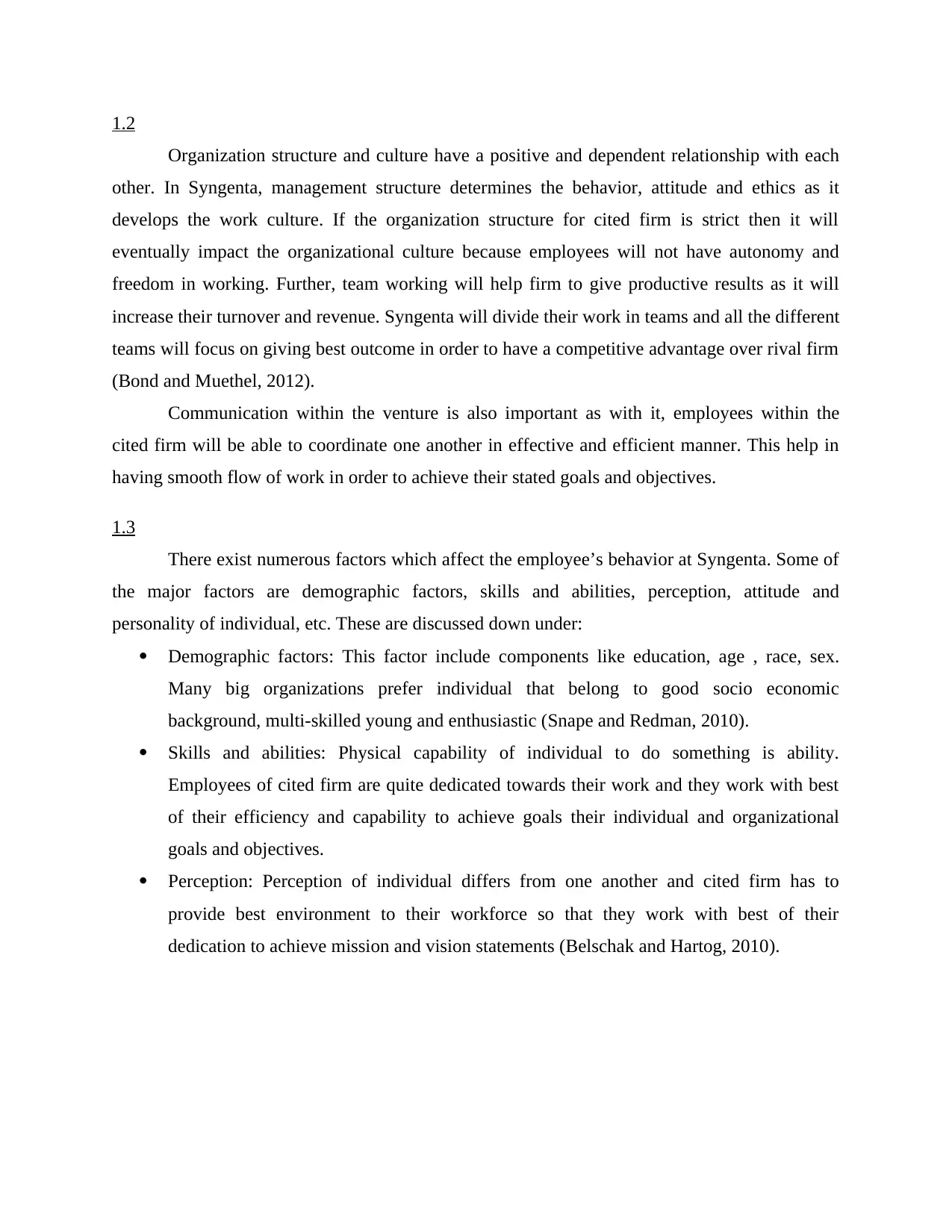
1.2
Organization structure and culture have a positive and dependent relationship with each
other. In Syngenta, management structure determines the behavior, attitude and ethics as it
develops the work culture. If the organization structure for cited firm is strict then it will
eventually impact the organizational culture because employees will not have autonomy and
freedom in working. Further, team working will help firm to give productive results as it will
increase their turnover and revenue. Syngenta will divide their work in teams and all the different
teams will focus on giving best outcome in order to have a competitive advantage over rival firm
(Bond and Muethel, 2012).
Communication within the venture is also important as with it, employees within the
cited firm will be able to coordinate one another in effective and efficient manner. This help in
having smooth flow of work in order to achieve their stated goals and objectives.
1.3
There exist numerous factors which affect the employee’s behavior at Syngenta. Some of
the major factors are demographic factors, skills and abilities, perception, attitude and
personality of individual, etc. These are discussed down under:
Demographic factors: This factor include components like education, age , race, sex.
Many big organizations prefer individual that belong to good socio economic
background, multi-skilled young and enthusiastic (Snape and Redman, 2010).
Skills and abilities: Physical capability of individual to do something is ability.
Employees of cited firm are quite dedicated towards their work and they work with best
of their efficiency and capability to achieve goals their individual and organizational
goals and objectives.
Perception: Perception of individual differs from one another and cited firm has to
provide best environment to their workforce so that they work with best of their
dedication to achieve mission and vision statements (Belschak and Hartog, 2010).
Organization structure and culture have a positive and dependent relationship with each
other. In Syngenta, management structure determines the behavior, attitude and ethics as it
develops the work culture. If the organization structure for cited firm is strict then it will
eventually impact the organizational culture because employees will not have autonomy and
freedom in working. Further, team working will help firm to give productive results as it will
increase their turnover and revenue. Syngenta will divide their work in teams and all the different
teams will focus on giving best outcome in order to have a competitive advantage over rival firm
(Bond and Muethel, 2012).
Communication within the venture is also important as with it, employees within the
cited firm will be able to coordinate one another in effective and efficient manner. This help in
having smooth flow of work in order to achieve their stated goals and objectives.
1.3
There exist numerous factors which affect the employee’s behavior at Syngenta. Some of
the major factors are demographic factors, skills and abilities, perception, attitude and
personality of individual, etc. These are discussed down under:
Demographic factors: This factor include components like education, age , race, sex.
Many big organizations prefer individual that belong to good socio economic
background, multi-skilled young and enthusiastic (Snape and Redman, 2010).
Skills and abilities: Physical capability of individual to do something is ability.
Employees of cited firm are quite dedicated towards their work and they work with best
of their efficiency and capability to achieve goals their individual and organizational
goals and objectives.
Perception: Perception of individual differs from one another and cited firm has to
provide best environment to their workforce so that they work with best of their
dedication to achieve mission and vision statements (Belschak and Hartog, 2010).
Secure Best Marks with AI Grader
Need help grading? Try our AI Grader for instant feedback on your assignments.
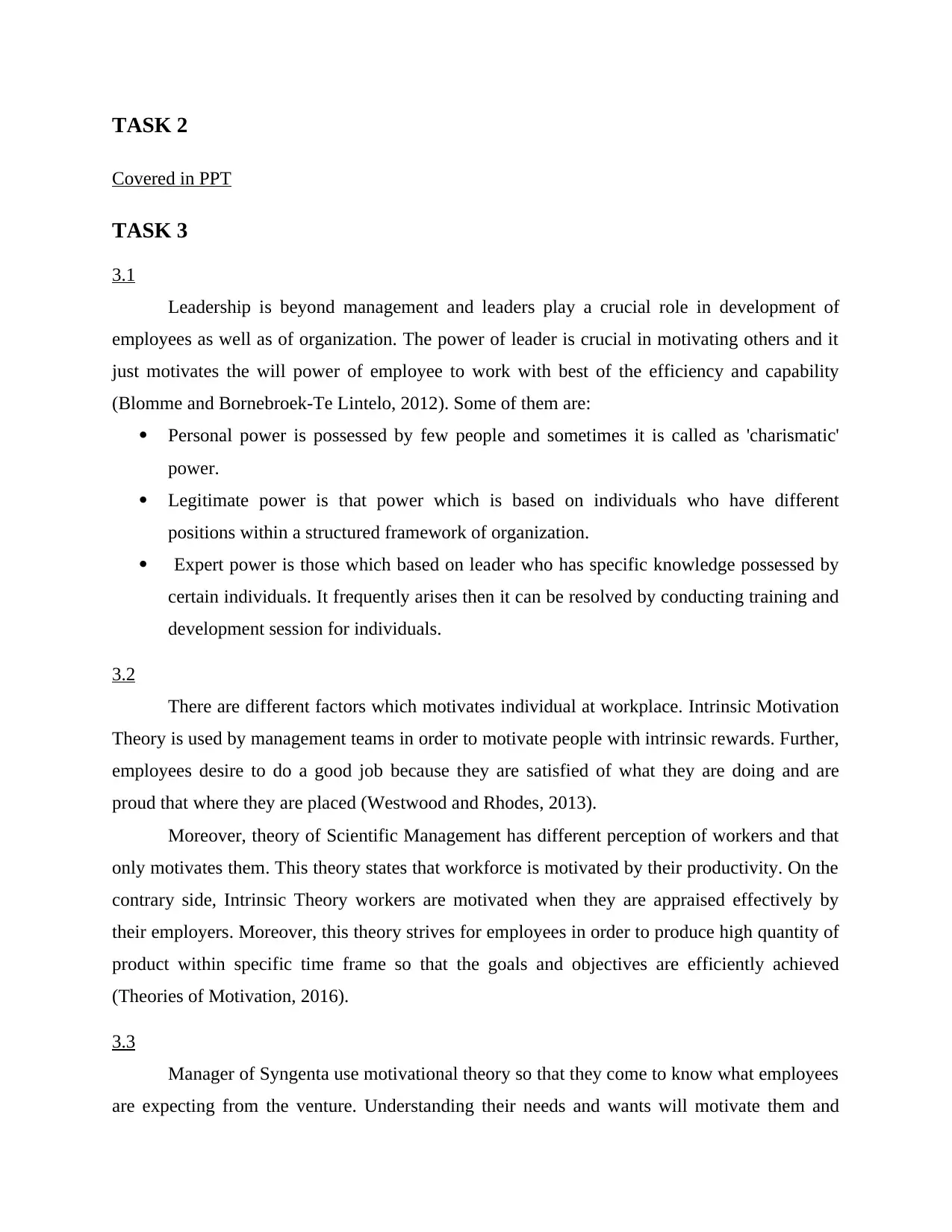
TASK 2
Covered in PPT
TASK 3
3.1
Leadership is beyond management and leaders play a crucial role in development of
employees as well as of organization. The power of leader is crucial in motivating others and it
just motivates the will power of employee to work with best of the efficiency and capability
(Blomme and Bornebroek-Te Lintelo, 2012). Some of them are:
Personal power is possessed by few people and sometimes it is called as 'charismatic'
power.
Legitimate power is that power which is based on individuals who have different
positions within a structured framework of organization.
Expert power is those which based on leader who has specific knowledge possessed by
certain individuals. It frequently arises then it can be resolved by conducting training and
development session for individuals.
3.2
There are different factors which motivates individual at workplace. Intrinsic Motivation
Theory is used by management teams in order to motivate people with intrinsic rewards. Further,
employees desire to do a good job because they are satisfied of what they are doing and are
proud that where they are placed (Westwood and Rhodes, 2013).
Moreover, theory of Scientific Management has different perception of workers and that
only motivates them. This theory states that workforce is motivated by their productivity. On the
contrary side, Intrinsic Theory workers are motivated when they are appraised effectively by
their employers. Moreover, this theory strives for employees in order to produce high quantity of
product within specific time frame so that the goals and objectives are efficiently achieved
(Theories of Motivation, 2016).
3.3
Manager of Syngenta use motivational theory so that they come to know what employees
are expecting from the venture. Understanding their needs and wants will motivate them and
Covered in PPT
TASK 3
3.1
Leadership is beyond management and leaders play a crucial role in development of
employees as well as of organization. The power of leader is crucial in motivating others and it
just motivates the will power of employee to work with best of the efficiency and capability
(Blomme and Bornebroek-Te Lintelo, 2012). Some of them are:
Personal power is possessed by few people and sometimes it is called as 'charismatic'
power.
Legitimate power is that power which is based on individuals who have different
positions within a structured framework of organization.
Expert power is those which based on leader who has specific knowledge possessed by
certain individuals. It frequently arises then it can be resolved by conducting training and
development session for individuals.
3.2
There are different factors which motivates individual at workplace. Intrinsic Motivation
Theory is used by management teams in order to motivate people with intrinsic rewards. Further,
employees desire to do a good job because they are satisfied of what they are doing and are
proud that where they are placed (Westwood and Rhodes, 2013).
Moreover, theory of Scientific Management has different perception of workers and that
only motivates them. This theory states that workforce is motivated by their productivity. On the
contrary side, Intrinsic Theory workers are motivated when they are appraised effectively by
their employers. Moreover, this theory strives for employees in order to produce high quantity of
product within specific time frame so that the goals and objectives are efficiently achieved
(Theories of Motivation, 2016).
3.3
Manager of Syngenta use motivational theory so that they come to know what employees
are expecting from the venture. Understanding their needs and wants will motivate them and
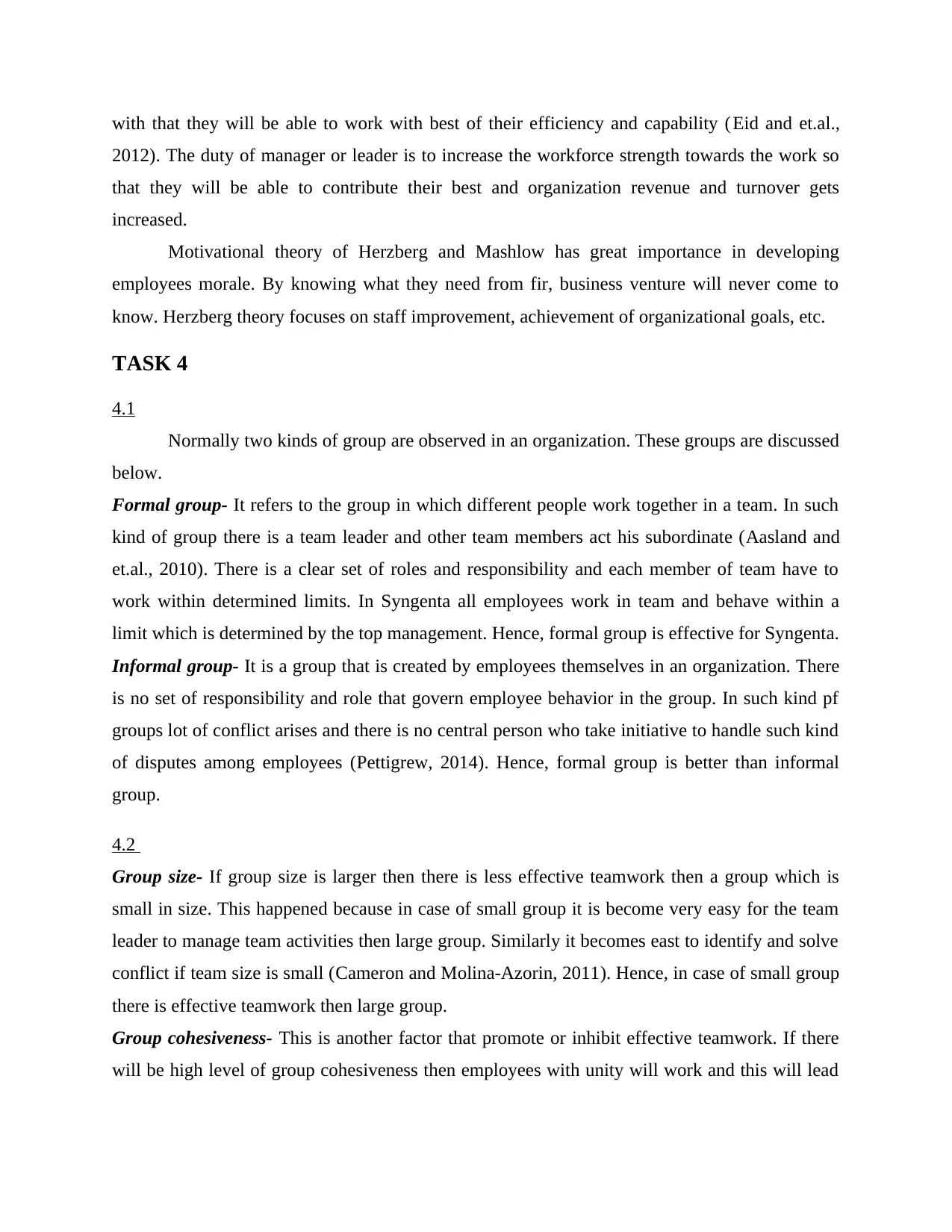
with that they will be able to work with best of their efficiency and capability (Eid and et.al.,
2012). The duty of manager or leader is to increase the workforce strength towards the work so
that they will be able to contribute their best and organization revenue and turnover gets
increased.
Motivational theory of Herzberg and Mashlow has great importance in developing
employees morale. By knowing what they need from fir, business venture will never come to
know. Herzberg theory focuses on staff improvement, achievement of organizational goals, etc.
TASK 4
4.1
Normally two kinds of group are observed in an organization. These groups are discussed
below.
Formal group- It refers to the group in which different people work together in a team. In such
kind of group there is a team leader and other team members act his subordinate (Aasland and
et.al., 2010). There is a clear set of roles and responsibility and each member of team have to
work within determined limits. In Syngenta all employees work in team and behave within a
limit which is determined by the top management. Hence, formal group is effective for Syngenta.
Informal group- It is a group that is created by employees themselves in an organization. There
is no set of responsibility and role that govern employee behavior in the group. In such kind pf
groups lot of conflict arises and there is no central person who take initiative to handle such kind
of disputes among employees (Pettigrew, 2014). Hence, formal group is better than informal
group.
4.2
Group size- If group size is larger then there is less effective teamwork then a group which is
small in size. This happened because in case of small group it is become very easy for the team
leader to manage team activities then large group. Similarly it becomes east to identify and solve
conflict if team size is small (Cameron and Molina-Azorin, 2011). Hence, in case of small group
there is effective teamwork then large group.
Group cohesiveness- This is another factor that promote or inhibit effective teamwork. If there
will be high level of group cohesiveness then employees with unity will work and this will lead
2012). The duty of manager or leader is to increase the workforce strength towards the work so
that they will be able to contribute their best and organization revenue and turnover gets
increased.
Motivational theory of Herzberg and Mashlow has great importance in developing
employees morale. By knowing what they need from fir, business venture will never come to
know. Herzberg theory focuses on staff improvement, achievement of organizational goals, etc.
TASK 4
4.1
Normally two kinds of group are observed in an organization. These groups are discussed
below.
Formal group- It refers to the group in which different people work together in a team. In such
kind of group there is a team leader and other team members act his subordinate (Aasland and
et.al., 2010). There is a clear set of roles and responsibility and each member of team have to
work within determined limits. In Syngenta all employees work in team and behave within a
limit which is determined by the top management. Hence, formal group is effective for Syngenta.
Informal group- It is a group that is created by employees themselves in an organization. There
is no set of responsibility and role that govern employee behavior in the group. In such kind pf
groups lot of conflict arises and there is no central person who take initiative to handle such kind
of disputes among employees (Pettigrew, 2014). Hence, formal group is better than informal
group.
4.2
Group size- If group size is larger then there is less effective teamwork then a group which is
small in size. This happened because in case of small group it is become very easy for the team
leader to manage team activities then large group. Similarly it becomes east to identify and solve
conflict if team size is small (Cameron and Molina-Azorin, 2011). Hence, in case of small group
there is effective teamwork then large group.
Group cohesiveness- This is another factor that promote or inhibit effective teamwork. If there
will be high level of group cohesiveness then employees with unity will work and this will lead
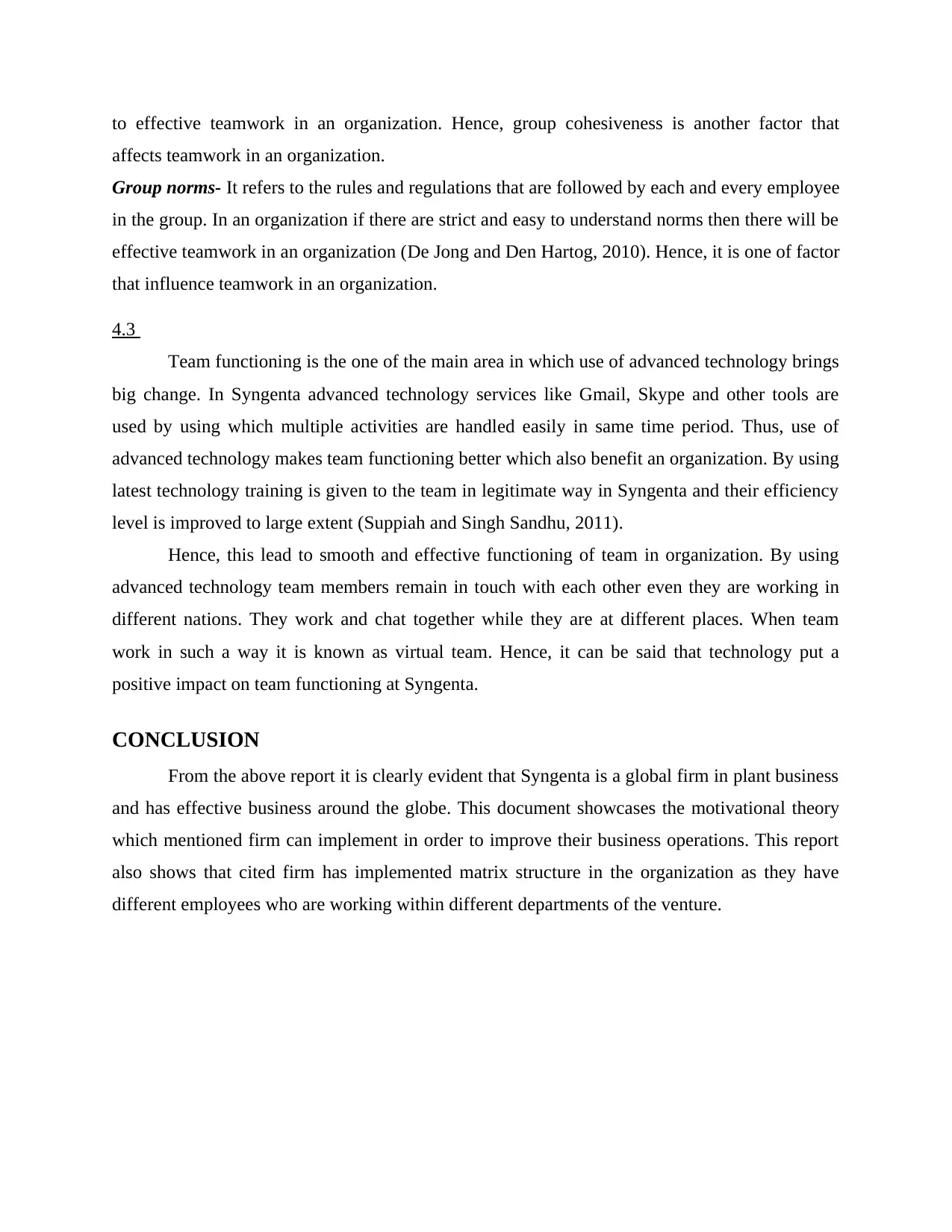
to effective teamwork in an organization. Hence, group cohesiveness is another factor that
affects teamwork in an organization.
Group norms- It refers to the rules and regulations that are followed by each and every employee
in the group. In an organization if there are strict and easy to understand norms then there will be
effective teamwork in an organization (De Jong and Den Hartog, 2010). Hence, it is one of factor
that influence teamwork in an organization.
4.3
Team functioning is the one of the main area in which use of advanced technology brings
big change. In Syngenta advanced technology services like Gmail, Skype and other tools are
used by using which multiple activities are handled easily in same time period. Thus, use of
advanced technology makes team functioning better which also benefit an organization. By using
latest technology training is given to the team in legitimate way in Syngenta and their efficiency
level is improved to large extent (Suppiah and Singh Sandhu, 2011).
Hence, this lead to smooth and effective functioning of team in organization. By using
advanced technology team members remain in touch with each other even they are working in
different nations. They work and chat together while they are at different places. When team
work in such a way it is known as virtual team. Hence, it can be said that technology put a
positive impact on team functioning at Syngenta.
CONCLUSION
From the above report it is clearly evident that Syngenta is a global firm in plant business
and has effective business around the globe. This document showcases the motivational theory
which mentioned firm can implement in order to improve their business operations. This report
also shows that cited firm has implemented matrix structure in the organization as they have
different employees who are working within different departments of the venture.
affects teamwork in an organization.
Group norms- It refers to the rules and regulations that are followed by each and every employee
in the group. In an organization if there are strict and easy to understand norms then there will be
effective teamwork in an organization (De Jong and Den Hartog, 2010). Hence, it is one of factor
that influence teamwork in an organization.
4.3
Team functioning is the one of the main area in which use of advanced technology brings
big change. In Syngenta advanced technology services like Gmail, Skype and other tools are
used by using which multiple activities are handled easily in same time period. Thus, use of
advanced technology makes team functioning better which also benefit an organization. By using
latest technology training is given to the team in legitimate way in Syngenta and their efficiency
level is improved to large extent (Suppiah and Singh Sandhu, 2011).
Hence, this lead to smooth and effective functioning of team in organization. By using
advanced technology team members remain in touch with each other even they are working in
different nations. They work and chat together while they are at different places. When team
work in such a way it is known as virtual team. Hence, it can be said that technology put a
positive impact on team functioning at Syngenta.
CONCLUSION
From the above report it is clearly evident that Syngenta is a global firm in plant business
and has effective business around the globe. This document showcases the motivational theory
which mentioned firm can implement in order to improve their business operations. This report
also shows that cited firm has implemented matrix structure in the organization as they have
different employees who are working within different departments of the venture.
Paraphrase This Document
Need a fresh take? Get an instant paraphrase of this document with our AI Paraphraser
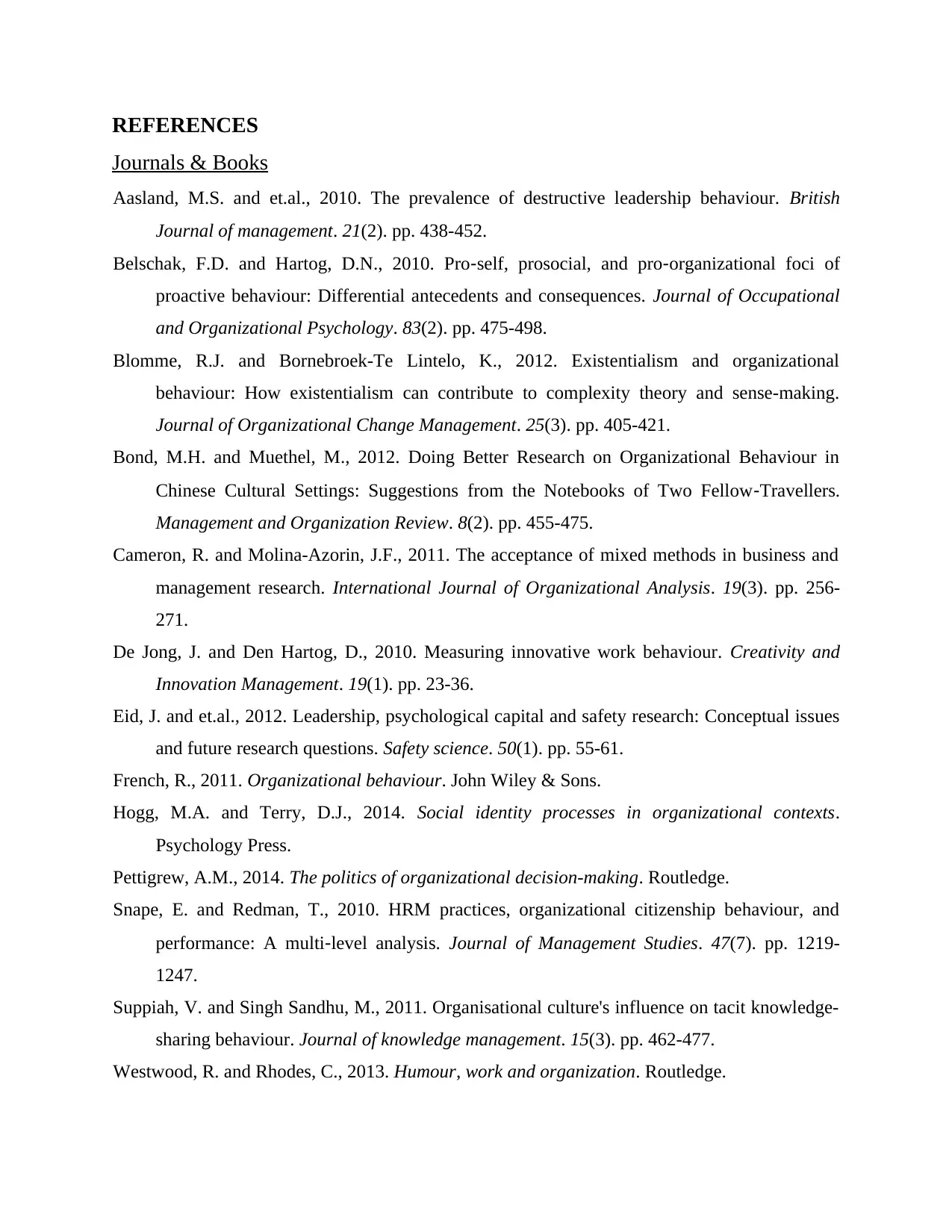
REFERENCES
Journals & Books
Aasland, M.S. and et.al., 2010. The prevalence of destructive leadership behaviour. British
Journal of management. 21(2). pp. 438-452.
Belschak, F.D. and Hartog, D.N., 2010. Pro‐self, prosocial, and pro‐organizational foci of
proactive behaviour: Differential antecedents and consequences. Journal of Occupational
and Organizational Psychology. 83(2). pp. 475-498.
Blomme, R.J. and Bornebroek-Te Lintelo, K., 2012. Existentialism and organizational
behaviour: How existentialism can contribute to complexity theory and sense-making.
Journal of Organizational Change Management. 25(3). pp. 405-421.
Bond, M.H. and Muethel, M., 2012. Doing Better Research on Organizational Behaviour in
Chinese Cultural Settings: Suggestions from the Notebooks of Two Fellow‐Travellers.
Management and Organization Review. 8(2). pp. 455-475.
Cameron, R. and Molina-Azorin, J.F., 2011. The acceptance of mixed methods in business and
management research. International Journal of Organizational Analysis. 19(3). pp. 256-
271.
De Jong, J. and Den Hartog, D., 2010. Measuring innovative work behaviour. Creativity and
Innovation Management. 19(1). pp. 23-36.
Eid, J. and et.al., 2012. Leadership, psychological capital and safety research: Conceptual issues
and future research questions. Safety science. 50(1). pp. 55-61.
French, R., 2011. Organizational behaviour. John Wiley & Sons.
Hogg, M.A. and Terry, D.J., 2014. Social identity processes in organizational contexts.
Psychology Press.
Pettigrew, A.M., 2014. The politics of organizational decision-making. Routledge.
Snape, E. and Redman, T., 2010. HRM practices, organizational citizenship behaviour, and
performance: A multi‐level analysis. Journal of Management Studies. 47(7). pp. 1219-
1247.
Suppiah, V. and Singh Sandhu, M., 2011. Organisational culture's influence on tacit knowledge-
sharing behaviour. Journal of knowledge management. 15(3). pp. 462-477.
Westwood, R. and Rhodes, C., 2013. Humour, work and organization. Routledge.
Journals & Books
Aasland, M.S. and et.al., 2010. The prevalence of destructive leadership behaviour. British
Journal of management. 21(2). pp. 438-452.
Belschak, F.D. and Hartog, D.N., 2010. Pro‐self, prosocial, and pro‐organizational foci of
proactive behaviour: Differential antecedents and consequences. Journal of Occupational
and Organizational Psychology. 83(2). pp. 475-498.
Blomme, R.J. and Bornebroek-Te Lintelo, K., 2012. Existentialism and organizational
behaviour: How existentialism can contribute to complexity theory and sense-making.
Journal of Organizational Change Management. 25(3). pp. 405-421.
Bond, M.H. and Muethel, M., 2012. Doing Better Research on Organizational Behaviour in
Chinese Cultural Settings: Suggestions from the Notebooks of Two Fellow‐Travellers.
Management and Organization Review. 8(2). pp. 455-475.
Cameron, R. and Molina-Azorin, J.F., 2011. The acceptance of mixed methods in business and
management research. International Journal of Organizational Analysis. 19(3). pp. 256-
271.
De Jong, J. and Den Hartog, D., 2010. Measuring innovative work behaviour. Creativity and
Innovation Management. 19(1). pp. 23-36.
Eid, J. and et.al., 2012. Leadership, psychological capital and safety research: Conceptual issues
and future research questions. Safety science. 50(1). pp. 55-61.
French, R., 2011. Organizational behaviour. John Wiley & Sons.
Hogg, M.A. and Terry, D.J., 2014. Social identity processes in organizational contexts.
Psychology Press.
Pettigrew, A.M., 2014. The politics of organizational decision-making. Routledge.
Snape, E. and Redman, T., 2010. HRM practices, organizational citizenship behaviour, and
performance: A multi‐level analysis. Journal of Management Studies. 47(7). pp. 1219-
1247.
Suppiah, V. and Singh Sandhu, M., 2011. Organisational culture's influence on tacit knowledge-
sharing behaviour. Journal of knowledge management. 15(3). pp. 462-477.
Westwood, R. and Rhodes, C., 2013. Humour, work and organization. Routledge.
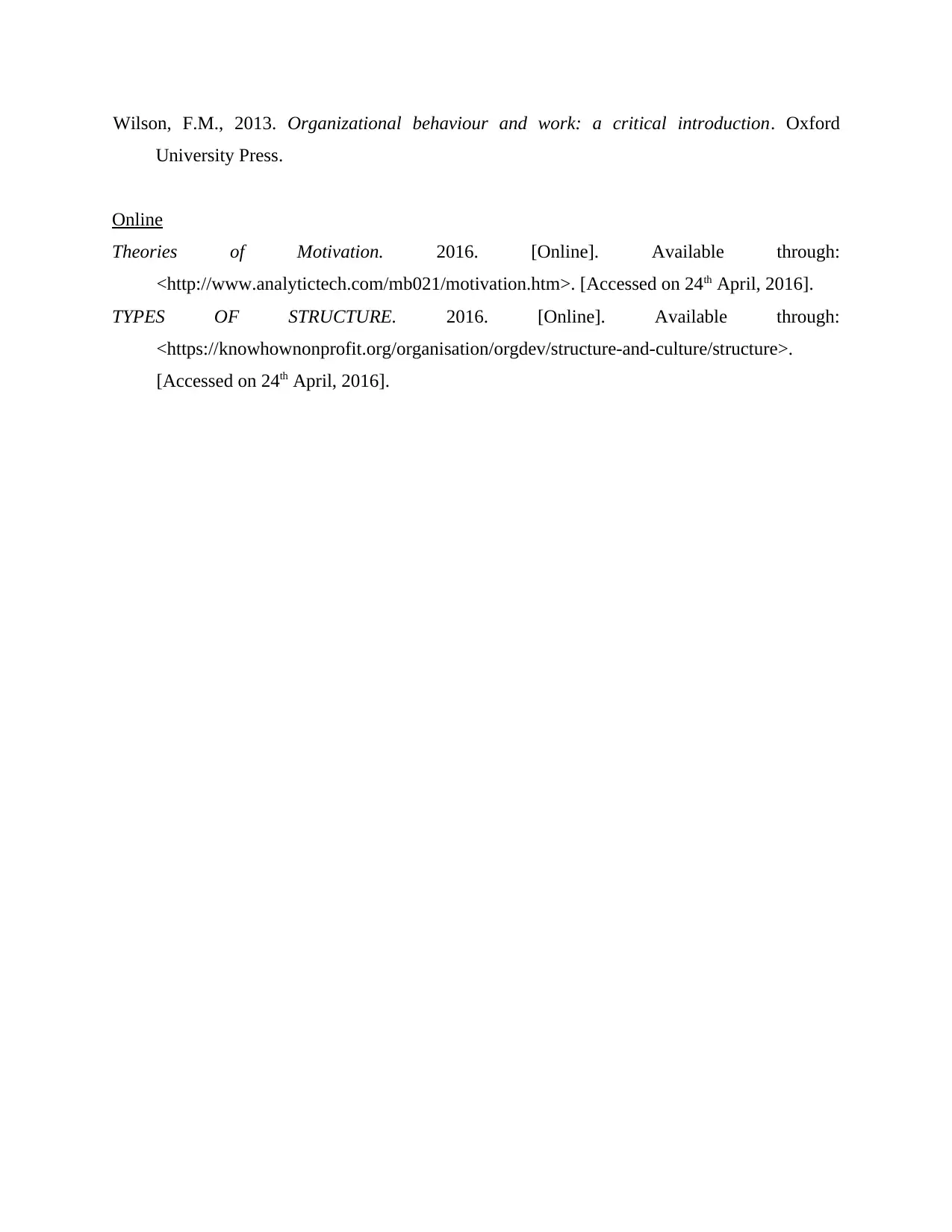
Wilson, F.M., 2013. Organizational behaviour and work: a critical introduction. Oxford
University Press.
Online
Theories of Motivation. 2016. [Online]. Available through:
<http://www.analytictech.com/mb021/motivation.htm>. [Accessed on 24th April, 2016].
TYPES OF STRUCTURE. 2016. [Online]. Available through:
<https://knowhownonprofit.org/organisation/orgdev/structure-and-culture/structure>.
[Accessed on 24th April, 2016].
University Press.
Online
Theories of Motivation. 2016. [Online]. Available through:
<http://www.analytictech.com/mb021/motivation.htm>. [Accessed on 24th April, 2016].
TYPES OF STRUCTURE. 2016. [Online]. Available through:
<https://knowhownonprofit.org/organisation/orgdev/structure-and-culture/structure>.
[Accessed on 24th April, 2016].
1 out of 9
Related Documents
Your All-in-One AI-Powered Toolkit for Academic Success.
+13062052269
info@desklib.com
Available 24*7 on WhatsApp / Email
![[object Object]](/_next/static/media/star-bottom.7253800d.svg)
Unlock your academic potential
© 2024 | Zucol Services PVT LTD | All rights reserved.





